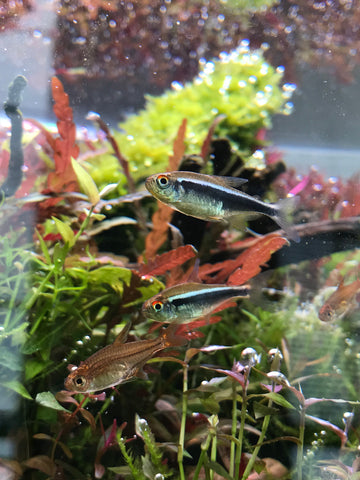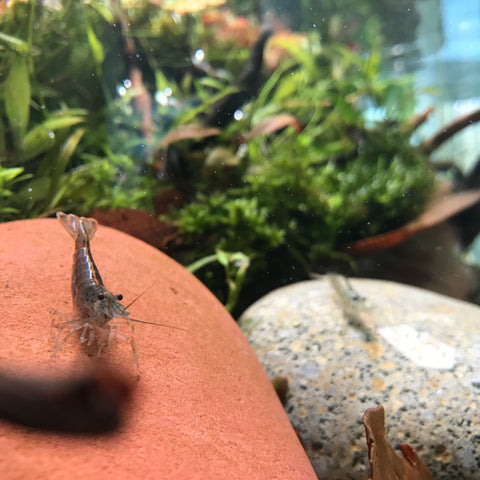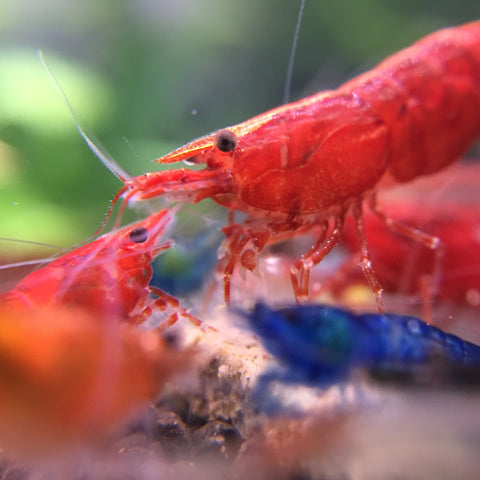Stocking Considerations for High-tech Aquariums
Aquascaping master Takashi Amano once commented that he has little interest in a specific aquarium- no matter how beautifully planted it may be- that lacks fish or other inhabitants. His goal was to produce an environment that was appealing to both human viewers and fish inhabitants. With this in mind, there are some special considerations to bear in mind when stocking a high-tech (intense light, with added carbon dioxide injection) aquarium. Unfortunately, many novice aquascapers do not realize the stressors they are inflicting upon their unsuspecting aquatic boarders. Certain fish and shrimp do better in high tech environments than others.

When stocking any aquarium, especially a high tech aquarium (already potentially prone to algae, even without livestock), it’s best to add less fish than you believe the tank can handle. On overstocked aquarium quickly accumulates nutrient buildup from uneaten food and fish waste. For example, with strong filtration, the maximum number of fish I would add to a twenty gallon is around twenty 1” fish.
Smaller fish tend to be best for high tech aquascapes for two reasons. First, it’s more aesthetically pleasing to see a large school of small fish harmoniously swimming in front of the plants than to have one or two large fish that make a mess of themselves and/or fight. Secondly, smaller fish will perceive the tank as being larger than it is, letting them feel more comfortable in their environment than a large, awkward fish. Regardless of the size or quantity of fish, it’s very important to keep up with water changes (at least once a week) to avoid waste buildup. This becomes increasingly important as the biomass of the fish in the tank increases in footprint.

Another key consideration is the intense light that will be shining into the tank. While excellent for growing beautiful plants, many fish species dislike bright light. Often, some of the most colorful and otherwise appealing fish like rasboras come from natural habitats with dark, tinted water that gets little light. Under intense light, fish like these can potentially feel stressed. It’s best to choose fish that enjoy bright light in their natural environment or fish that are comfortable with swimming in more open water. In any case, it’s good to provide some hiding places- hardscape such as driftwood, or tall stem plants, for example- for fish to make use of when feeling distressed or antisocial. Imagine how you would feel being under a spotlight, on stage, 24/7!
In a low tech or unplanted tank, little material is being added to the water beyond fish food. In a high tech tank, difficult plants demand the addition of fertilizer, injected carbon dioxide, and other supplements. While many fish can tolerate these additives in appropriate amounts, excess quantities can prove fatal. Excess carbon dioxide can outright kill shrimp or fish, or cause them to jump out of the tank (seeking a more favorable environment nearby). For this reason, it’s best to use a drop checker or bubble counter to ensure that carbon dioxide levels are appropriate. Shrimp are especially sensitive to additives containing excess metal: avoid adding iron supplements or using copper based fish medications to tanks containing shrimp. Trace amounts of these metals that may be present in complete fertilizers, such as UNS Plant Food All In One Aquatic Plant Fertilizer, will not harm shrimp or fish in smaller doses. As an aside: contrary to popular belief, complete fertilizers provide ample iron for growing bright red plants, and if used, additional iron is not needed. If your red plants are not turning red enough, do not reach for extra supplements: buy a light fixture with higher intensity or a better wavelength spectrum.

With these ‘ground rules’ in place, you might be wondering what specific species are particularly suited (or ill-suited) to high tech aquascapes. Some excellent candidates include Neocaridina shrimp, Amano shrimp, any of the neon tetras, ember tetras, Microdevario kubotai, scarlet badis, cardinal tetras, corydoras, and otocinclus. In my experience, rasboras, ricefish, and killifish all tend to have poor outcomes in tanks with injected carbon dioxide. It goes without saying that large, active fish, such as goldfish, plecostomus, or African rift lake cichlids, do not belong in any smaller, planted aquascape due to the lack of balance and potential destruction they may cause. Finally, Caridina shrimps such as Taiwan bees tend to do especially poorly with carbon dioxide injection, in contrast to their neocaridina cousins.
Please remember that while this is a guide based on my own observations and thoughts, it is by no means exhaustive, and there will always be exceptions or omitted points to any sort of ‘rulebook’. Too many of us have accidentally killed our pets, or at least put them through unnecessary distress. Hopefully, this guide will help prevent that from happening in your high tech tank!
Tell us - Was this article helpful? Please leave a comment below!
If you have any questions regarding this article, please DM us on Instagram, Facebook, or email support@buceplant.com so we can assist you - @buceplant







Comments
Leave a comment